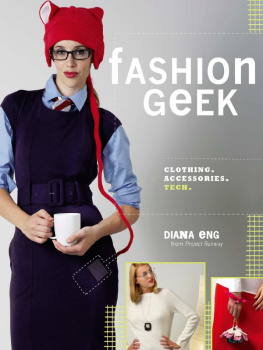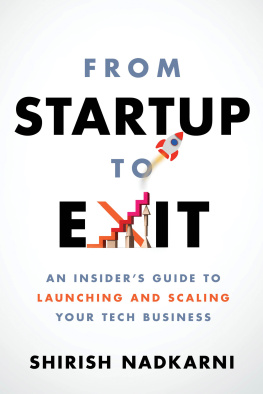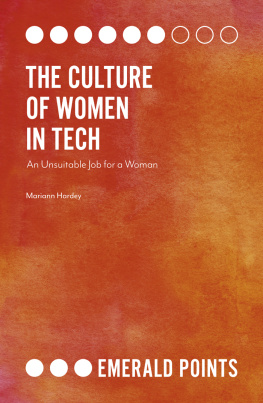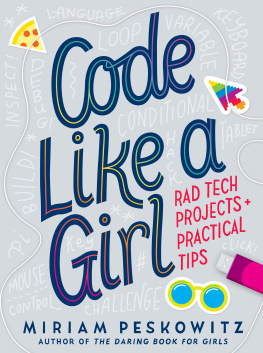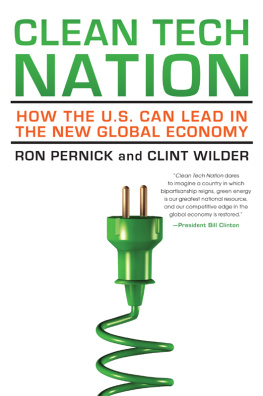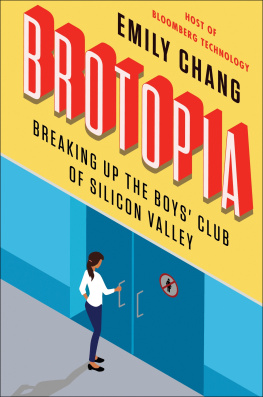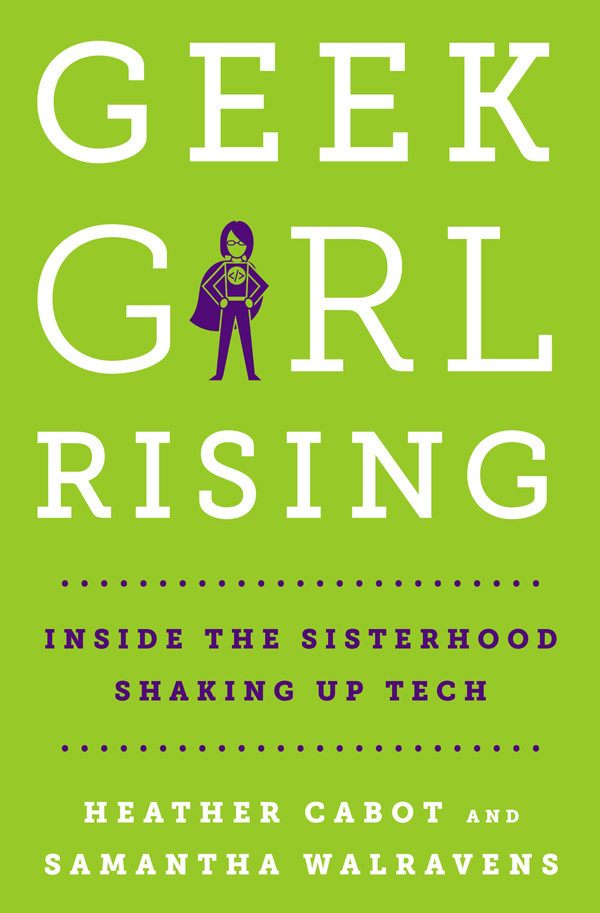Contents
Guide

The author and publisher have provided this e-book to you for your personal use only. You may not make this e-book publicly available in any way. Copyright infringement is against the law. If you believe the copy of this e-book you are reading infringes on the authors copyright, please notify the publisher at: us.macmillanusa.com/piracy.
To our children and Geek Girls everywhere, who are building the future
As mothers to young daughters obsessed with musical.ly, Minecraft , and messaging their friends, we embarked on this project to better understand why the number of women working in technology has been on a steady decline since the 1980s and what can be done to reverse the trend. While the media focused on sexism and the exclusive boys club in Silicon Valley as the culprits keeping women out, we uncovered a different story: a powerful grassroots movement of women entrepreneurs and technologists who were not asking for permission from Silicon Valleyor anyoneto take part in the digital revolution. These are the stories we decided to share in this book.
It was not hard to find amazing women innovators. They were everywhere! We interviewed more than two hundred fifty people for this book. As we started to draft the manuscript, we had to make difficult decisions about which stories to include. This led us to create a digital platform, www.geekgirlrising.com, to highlight the many accomplished women we interviewed but whose stories we could not fit within the confines of a printed book. Thank you to the fearless entrepreneurs, technologists, investors, and advocates in Silicon Valley, Silicon Alley, and tech hubs around the country who allowed us to tell their stories. Thank you for trusting us, for sharing your journeys, for allowing us into your homes and workplacesand for blazing a trail for other women and girls to follow in the digital revolution. This book is our gift to you.
Finally, covering startups is inherently tricky. Early stage ventures endure captivating highs and lows, and as reporters we experienced a healthy dose of suspense as we followed many stories over many years (in some cases since 2011). Given the lightning speed with which the tech startup world changes, we hope readers will appreciate that this book is a snapshot of a moment in time. We decided to focus on the years the women in tech conversation emerged as part of the national dialogue2014 to the present day. We know that things will have changed by the time you are reading the book but hope you will appreciate our efforts to report the stories as they unfolded (especially against the dramatic backdrop of the polarizing 2016 presidential race and Donald Trumps win). We look forward to chronicling these womens incredible journeys in the future.
Women have been trained to speak softly and carry a lipstick.
Those days are over.
B ELLA A BZUG
Debbie Sterlings stomach flip-flopped as she waited for the commercial that would change the trajectory of her nascent toy company. It felt like a lifetime ago, but she had set out only two years earlier to upend the worlds image of engineers as a lonely bunch of boy geniuses and introduce a new kind of role modela spunky, tool beltwearing action figure with long, blonde, curly hair named Goldie.
It wasnt an easy sell. Big toy companies quickly dismissed GoldieBlox, a product designed to teach girls engineering, complete with a tool kit of pulleys and shafts, as too niche. But that didnt deter Debbie, who fondly remembers challenging boys to arm-wrestling contests in the second grade. She set out to prove the naysayers wrong by taking her story to Kickstarter, where she planned to raise $150,000 so she could manufacture the first run of Goldies Spinning Machine , a storybook and building set.
In an endearing video Debbie made her simple Kickstarter pitch while wearing jeans and a sleeveless violet top as she sat cross-legged on the floor of her apartment. Scenes showed little faces lighting up as pigtailed tots played with the one and only prototype. In the video, shot by Debbies husband, Beau, she told viewers they could inspire their daughters to be more than just a princess by helping Debbie fund the first production run. The play sets would mesh girls love of storiesplayers follow the adventures of main character Goldie and her friendswith fun design challenges featuring wheels, axles, catapults, and gears. Girls would build simple machines alongside Goldie. The message went viral. In thirty days Debbie raised more than $285,000 and was able to produce her first order of five thousand units, which quickly ballooned to forty thousand to keep up with demand. Suddenly the toy stores were calling her.
Now, fast-forward to Super Bowl Sunday. Debbie, the real-life Goldie, the curly-haired inventor with the infectious smile, was about to go prime time. She hoped the thirty-second commercial would fuel her mission to inspire girls to break into the boys club and start seeing themselves as tomorrows builders and problem solvers.
GoldieBlox had won the big-time adworth an estimated $4 millionin a small business contest run by Intuit, parent company of QuickBooks and TurboTax. Debbie flew her entire family and twelve team members from San Francisco to Intuits tricked-out fete on the top floor of Manhattans Gramercy Park Hotel, which featured glitzy cocktails, hors doeuvres passed by servers, and even a photo booth. Just being in the room was a thrill, but the waiting was killing her.
Finally, the familiar drumbeat of the 1980s rock anthem Cum on Feel the Noize poured out of the screen over a raucous scene of adorable little girls in princess outfits who were tearing off their glittery tiaras and running through the streets to a park, where they constructed a giant rocket out of their dolls, pink ponies, and sparkly playthings. They sang triumphantly:
Come on, ditch your toys
Girls make some noise
More than pink, pink, pink
We want to think!
As the rocket launched toward the sun, the room exploded in cheers and applause. It was a game changer, and Debbie could feel it as the music faded away.
We specifically did not want the commercial to be about the product. It 100 percent needed to be about the social mission that were on and educating parents about shining a light on the pink [toy] aisle and how limiting it can be in terms of what girls think they are capable of and getting them interested in science, engineering, and math, she reflected when we spent the afternoon with her at Toy Fair in New York City two years later.
Mission accomplished. The commercial, and its unapologetically feminist message, touched off the first of many triumphs in 2014, a year that would galvanize disparate groups of people around the country who had long been agitating about the tiny number of women and people of color in key technical and leadership roles in Silicon Valley. That was the year the issue of women in tech started to matter to the masses. The timing was right. Facebook COO Sheryl Sandbergs Lean In , published just eleven months earlier, was sparking urgent conversations about women, leadership, parental leave, and the pay gap. It was inevitable that the dialogue would turn to inequities in technology itself. Smartphones and digital media had become central to most American lives, and women were the primary consumers, yet they were largely absent from the teams building new technologies. As a piece in the New York Times s Motherlode blog in March 2014 aptly pointed out, If men could breastfeed, surely the breast pump would be as elegant as an iPhone and as quiet as a Prius by now.


